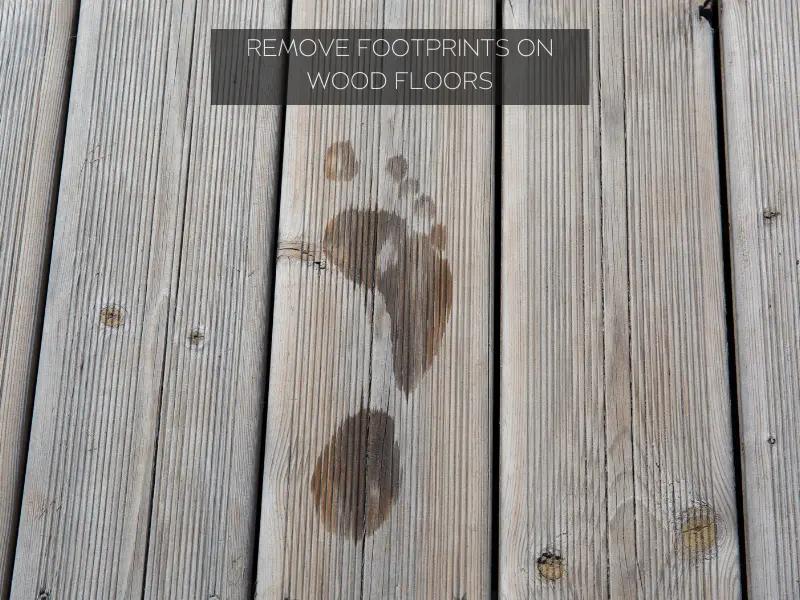How to Prevent Footprints on Wood Floors (Ghosting)
Footprints on your wooden floor, also called ghosting on wood floors, can be an unsightly appearance to your home. Although people may shrug off the prints as part of modern-day living, footprints are a stain that can be a challenge to eradicate especially on dark wood floors.
You can try a few techniques to help you prevent and remove footprints on your floor. Most methods are cost-effective and easy to apply in a DIY setting.
Why does my wood floor show footprints?

Your wood floor may show footprints because of several reasons. A primary
cause for footmarks to appear on your floor is oil, grease, and other debris left over during a cleaning.
Some hardwood floors have an oily film on the surface that helps to safeguard the wood from water/moisture damage. The oily film may also cause footprints to appear on the floor surface even after cleaning.
Most wood cleaning agents are not suitable for wooden floors and might cause the floor to appear dull (and cause the footprints to appear).
The footprints can cause your floor to appear unsightly and affect the quality of your living space. You can try several methods to help you remove unwanted footprints from your floor.
How to remove footprints on wood floors
You can choose between several methods to fix ghosting on timber floors. Most of the methods I’ve discussed below provide long-lasting solutions to your problem and are applicable in a DIY setup.
Here are the most effective ways to remove and stop footprints on wood floors:
Clean your floor using vinegar
Vinegar is an effective cleaning agent that can help you deal with numerous household issues, including greasy surfaces and footprints on your wood-based floor. Vinegar actively dissolves grease (and oil) responsible for causing footprint stains to appear on your flooring. It is also environmentally friendly and its use has minimal environmental implications.
You can start by ensuring that your floor is clean and free from any debris such as dust, hair, etc. Use a dry mop to clean your floor of solid residue and to expose the markings on your floor surface.
Carefully mop the floor surface using a warm water solution without adding a cleaning agent. Warm water helps to remove grease (and other oil stains) from your timber flooring. Warm water can also help remove temporary footprints (that are not completely dry) from your floor. Give your floor about 15 – 20 min to dry.
Dilute vinegar with water in the ratio of 1:3 where water quantity should average about 3 times the amount of concentrated vinegar in the mixture. Mop the affected surface until the footprints disappear.
You can also use a spray bottle to spray the vinegar-water mixture on the affected surfaces.
Lastly, use a microfiber cloth or dry mop to clean the affected surfaces while inspecting your work for any residue or markings.
Vinegar is an ideal choice for eliminating ghostings on timber floors because of its accessibility, pocket-friendly pricing, disinfectant, and non-toxic attributes. It also leaves your floor with an attractive shine that can change the mood within your space.
Mix your cleaning water with dishwasher fluid
You can remove footprints and other greasy residues by cleaning your floor with a dishwasher fluid and water mixture. Dishwasher fluid has active anti-grease properties that can help you remove ghostings from your wooden floors easily.
Start by ensuring your floor is free from debris and other solid residues such as paper bits, soil, etc. Carefully sweep the entire floor surface using a dry mop to round up any dirt that could be lying about on the floor surface.
Mix a tablespoon of dishwasher fluid in every five liters of warm water in a ratio of 1:5 to create a dilute solution. You can also add a few drops of citric acid for the extra fragrance and added cleaning strength. Carefully mop the affected surface until the stains vanish. Another idea is to use a spray bottle to spray the diluted concoction on the floor before wiping it off using a damp cloth. Finish up your cleaning by using a clean mop to dry the surface.
Mixing dishwasher fluid with warm water can be a sustainable way to ensure that your wooden floors remain free from unsightly footprints, grime, and other hard-to-clean substances. It is also relatively safe to use within a DIY setting.
Swab your floor with Acetone
Acetone (nail polish remover) can help you keep your dark wooden floor surface clean and well maintained. The chemical is a water and oil-soluble solvent that doubles up as a viable alternative when dealing with footprints on your wooden floor.
Always ensure that your floor is clean and free from debris. You can choose to sweep your floor using a dry mop or vacuum the entire surface before using acetone to remove footprints and other hard-to-remove stains from your floor surface. You need to take care, however, to ensure that you don’t damage your wooden flooring. Spilling acetone on your floor may cause damage to the finish.
Start by sweeping your floor and ensuring that the surface is debris free before using acetone to remove the footprints. A spray bottle may be a convenient choice considering that acetone has a high evaporation rate compared to other solvents.
Spray acetone over the affected surface and wipe the footprint markings quickly before the acetone evaporates. Repeat the process until you are confident that the floor does not have any such markings. Check if your work is complete by mopping the affected area with a wet mop.
Use TSP to remove grease from your floor
TSP (Tri-sodium phosphate) is an effective agent for removing footprints and other greases/oil stains from your floor. Its use is ideal for hardwood, painted, and unpainted wood floors.
Start by ensuring that your floor is clean. You can try using a dry mop to wipe debris, dirt, and other solids from our floor. A clean surface also makes it easy for you to identify the level of damage to your floor.
Prepare your TSP mixture using warm water and an adequate quantity of TSP powder. The ideal powder-to-water ratio should be 1:4. (You can use ¼ cup of the cleaning agent for every gallon of warm water).
Divide the floor into small sections and use a sponge to clean the affected areas. Remember to use gloves and other protective equipment when cleaning your floor. The chemical can irritate your skin and other sensitive body organs.
Rinse your floor using warm water and repeat the process until you are confident that your flooring is clean.
Ways to prevent the footprints
Having to deal with ghosting on your floor should be the last thing you do. It is better to prevent the damage beforehand by engaging in small regular tasks to keep your floor in top-notch condition.
Clean your floor regularly
Regular cleaning prevents the build-up of grime, grease, and other oil-based stains that cause footprints to appear on your floor.
Give your floor a through was or steaming session at least once or twice a month. How often you clean your floor depends primarily on foot traffic. Regular cleaning also makes it easier to identify and maintain your timber floor.
Sweep your floor regularly
Regular sweeping can help you maintain your timber floor by reducing the accumulation of debris that can cause additional damage if left unchecked.
Sweeping also helps remove traces of essential yet potentially harmful household products such as salt dust. (salt can damage hardwood floors over time, so remember to sweep salt spills quickly). If possible, it is best to vacuum your floor daily though you can formulate a weekly schedule to help you keep up with the tasks.
Use a soft broom when sweeping over laminated flooring. Stiff bristles can affect the wood’s finish and cause damage over time.
Avoid using soap-based products on your floor
Some commercial products come off as ideal solutions for your floor cleaning needs. The only issue with such products is that some commercial cleaning agents have soap-based features that may remain an oily film on your flooring after cleaning.
The oil remains after cleaning, making it much easier for footsteps, grime, and other oil stains to stick on your floor over time. When cleaning a timber floor, try non-soap detergents, vinegar, or steam to prevent oil accumulation on your floor surface.
